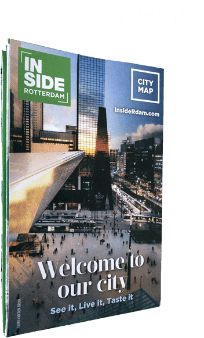Hulstkamp Building: A Future-Proofed City Icon
‘HULSTKAMP GEBOUW’. Every Rotterdammer knows the handsome building with the bright red lettering on Noordereiland, yet they might not be able to say much about its130-year history. Now, after a restoration, the building is back to its former splendour, and it’s time to get up close and personal.
Words: Irene de Vette
Noordereiland (‘Northern Island’) is a late 19th-century man-made island, which originated from the construction of the Koningsharbour. At the time, Rotterdam was in a building frenzy, with the harbour expanding no less so than on the new Noordereiland. The young local architect, Jacobus Pieter Stok, rode the wave of new construction and received a factory commission from British company, Laming&Sons, in 1888.
At Maaskade, Stok created a sizeable four-storey building with vaulted roofs, and a facade abundantly decorated with cornices, white limestone bands, and bronze and stone ornaments. Quite common for its architectural style, the exterior revealed nothing of its inside purpose: a modern margarine and cheese factory. Stok was influenced by the Dutch Neo-Renaissance, a revivalist style which celebrated the mannerist architecture of the Dutch Golden Age. Or, as Anne Mieke Backer puts it: “The 17th-century seen through the rose-tinted glasses of the 19th century.” Backer is a historian, publisher and long-term resident of the Noordereiland. “Because Rotterdam doesn’t have many historic buildings left, we cherish all that’s old. The Hulstkamp building, with its many embellishments, has become iconic in our city,” she says.
From factory to party centre
Competition was fierce in the margarine industry, and when Laming went bankrupt in 1919, distillery Hulstkamp & Son & Molijn moved into the building. Now it was jenever, a popular local tipple, that was produced, aged and transported from here, with sometimes as many as seven rows of barges moored along the quay. During World War II, the building was occupied by the Germans in an attempt to take over the city. Save for bullet holes, the building miraculously survived heavy fighting and subsequent city bombings.
When Hulstkamp was bought in 1979, the factory stood empty again. “Can you believe that in the 70s a project developer wanted to raise it to the ground to build a parking garage?”, says Iris Lamers-Hoogeweegen, a former resident of the building. Lamers not only lived there for over 35 years, she was also the daughter of the last Hulstkamp owner. She has fond memories of playing on the factory floors as a young girl. “My brothers and I were playing football and hide and seek among the barrels. This building is one that needs to be cared for. Until this day I am grateful that my father asked Mayor Van der Louw to have the building listed, saving it from demolition.”
As a monument, the Hulstkamp building was bought by Rotterdam entrepreneur, Tom Westermeijer, in 1979 who –quite rigorously – converted the interior to a party and event space. The courtyard was transformed into a light-filled winter garden, the distilleries into balcony-lined ballrooms. The building was acquired by the Thon Group in 1984, who licenced luxury caterer Maison van den Boer to start hosting events. Up until today, the ground floor is the scene of weddings, conferences, business events and even dance parties, while the other floors function as offices for multiple companies.

Facelift
Over the last few years it became clear that the building’s facade needed special attention. “Restoration proved to be an arduous task, since the building is a listed monument,” explains Jan Mark Vink of project developer Van Omme & De Groot. Vink was happy to take on the task, though. “As a child, I visited the building when the Dutch Marine Corps Museum washoused here. It turned out that all of our crew, from plumbers to carpenters, had a similar special connection to the building, everyone was exceptionally proud to work on it,” he says. Covered in scaffolding for 14 months, the facade was repaired and renewed where needed. Bricks and stones were taken out one by one, cleaned, coloured according to a special procedure, and then carefully placed back.“ The most difficult part was sourcing the same materials as were used 130 years ago to replace damaged parts. If you use even a slightly different type of stone you would see it immediately,” Vink says.

With its facelift, the Hulstkamp Building secured its iconic position in the Rotterdam cityscape, a remainder of an industrial city’s past whereby hyper-modern high-rises are increasingly on the horizon.
[Heading photo by: Maison van den Boer]












